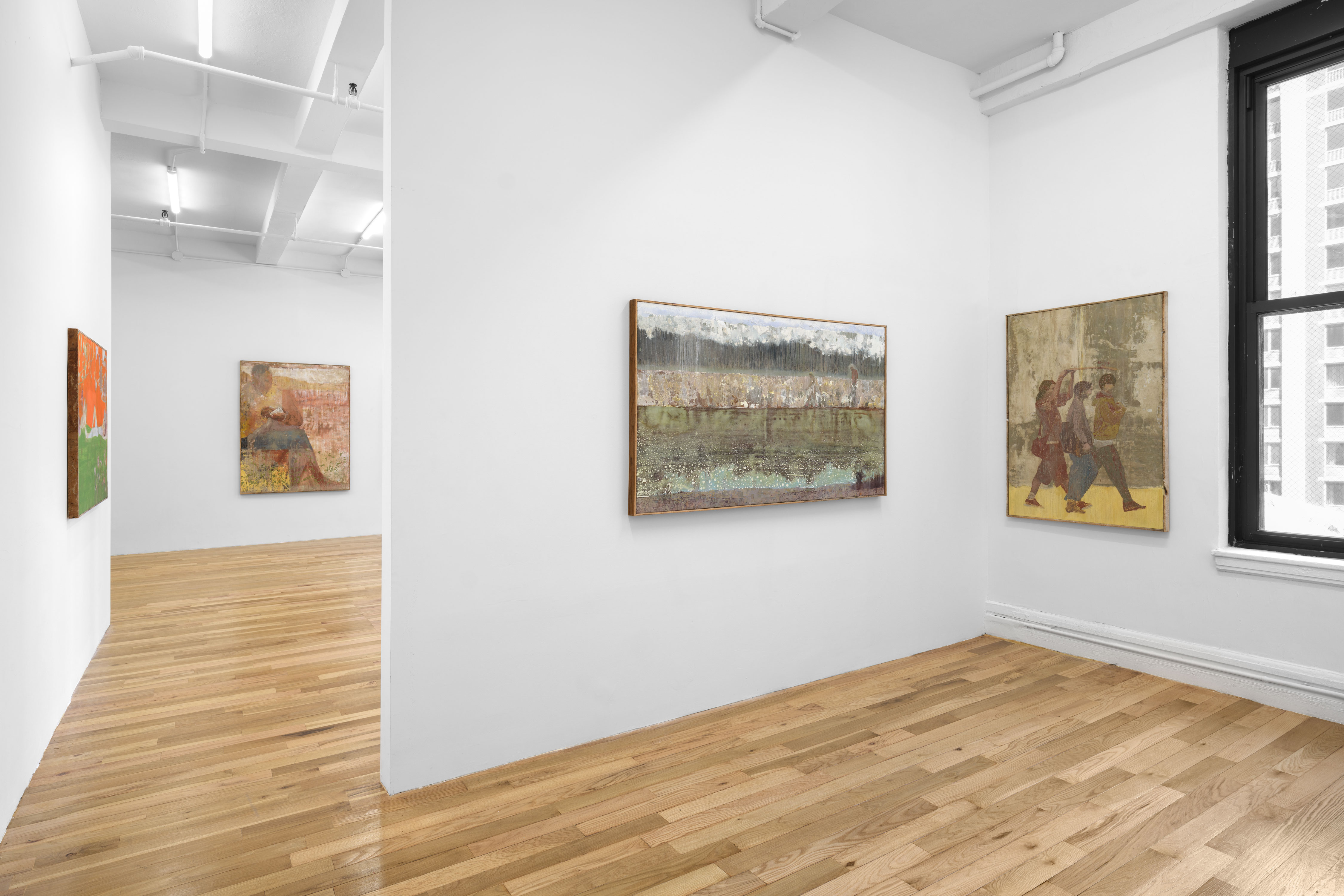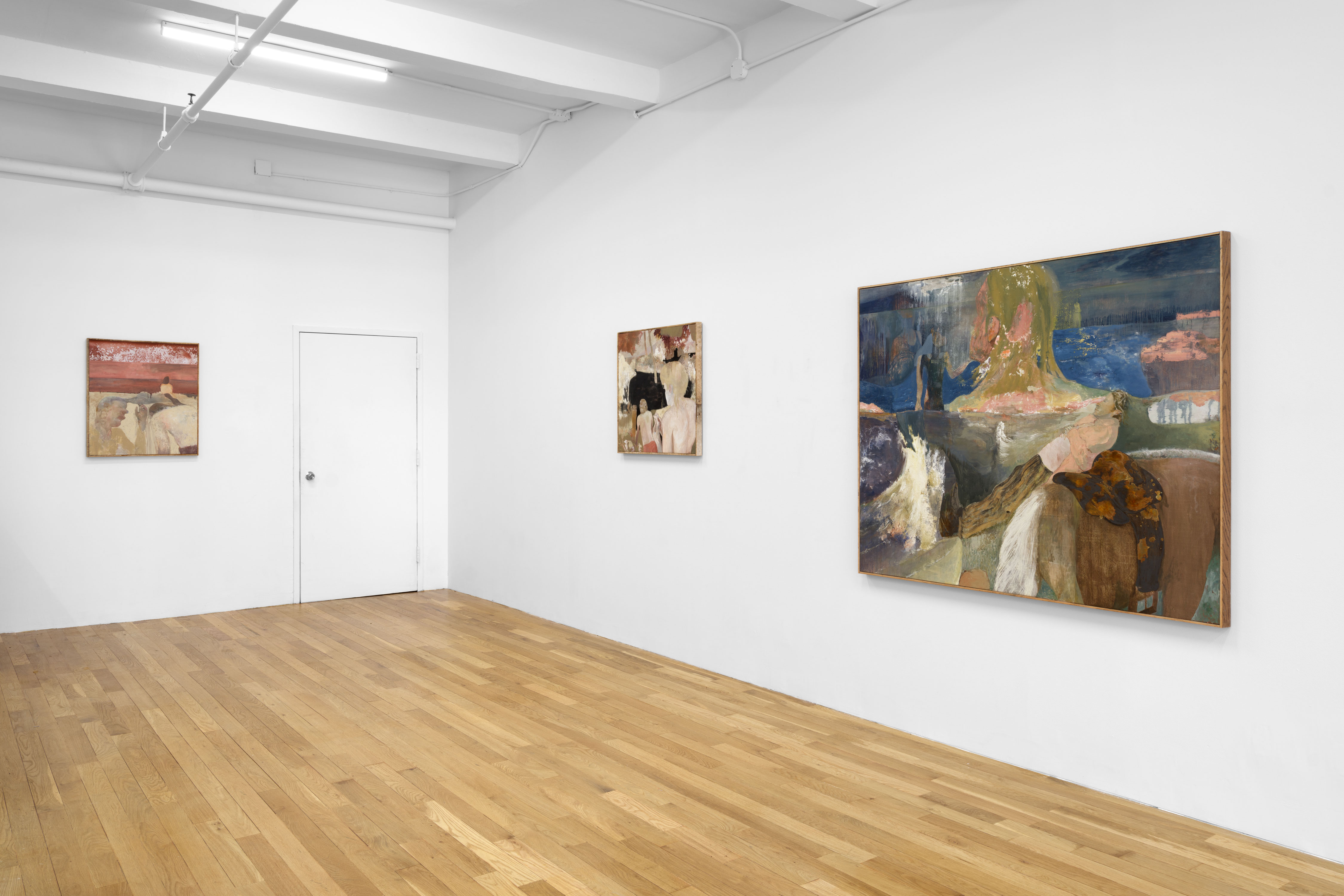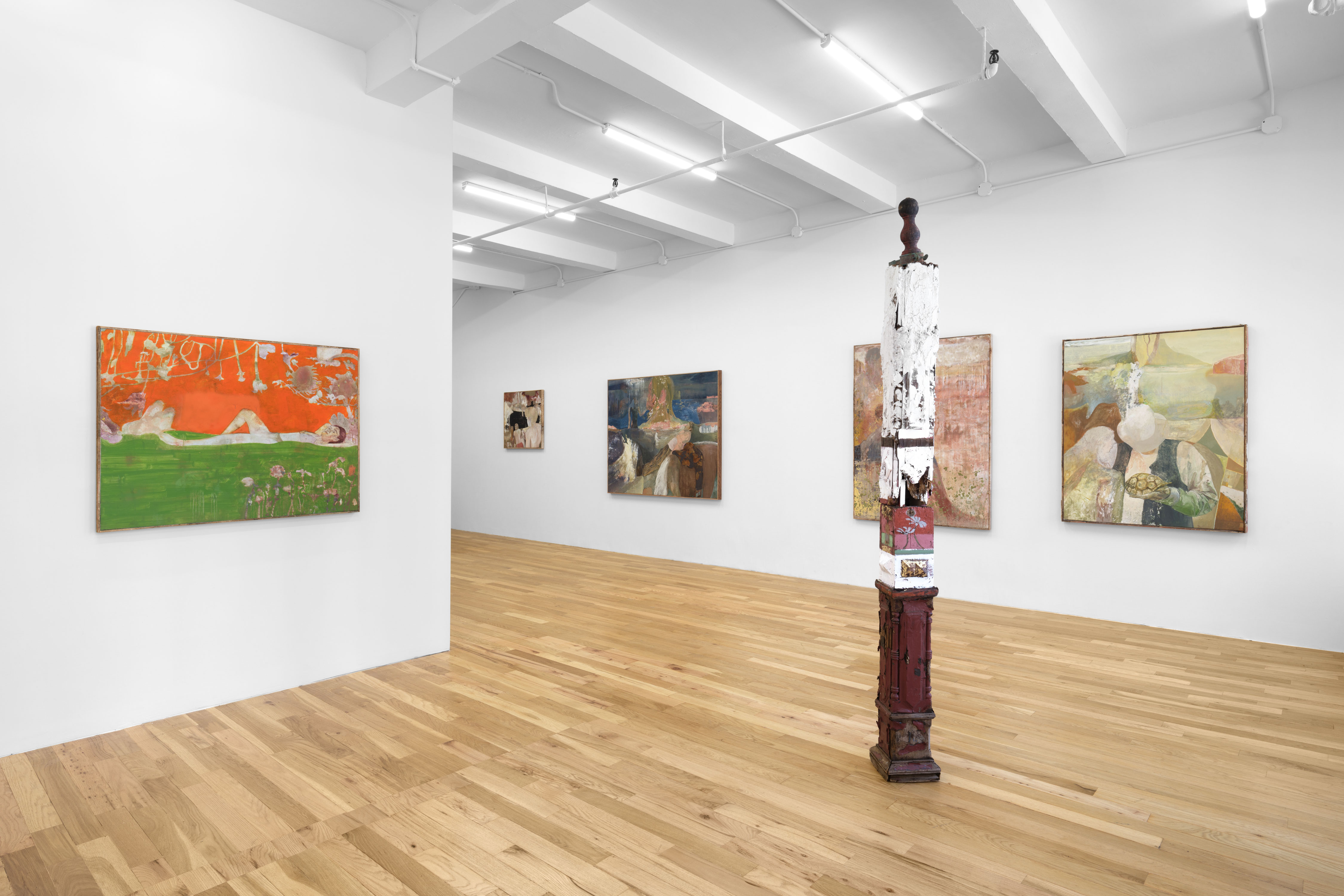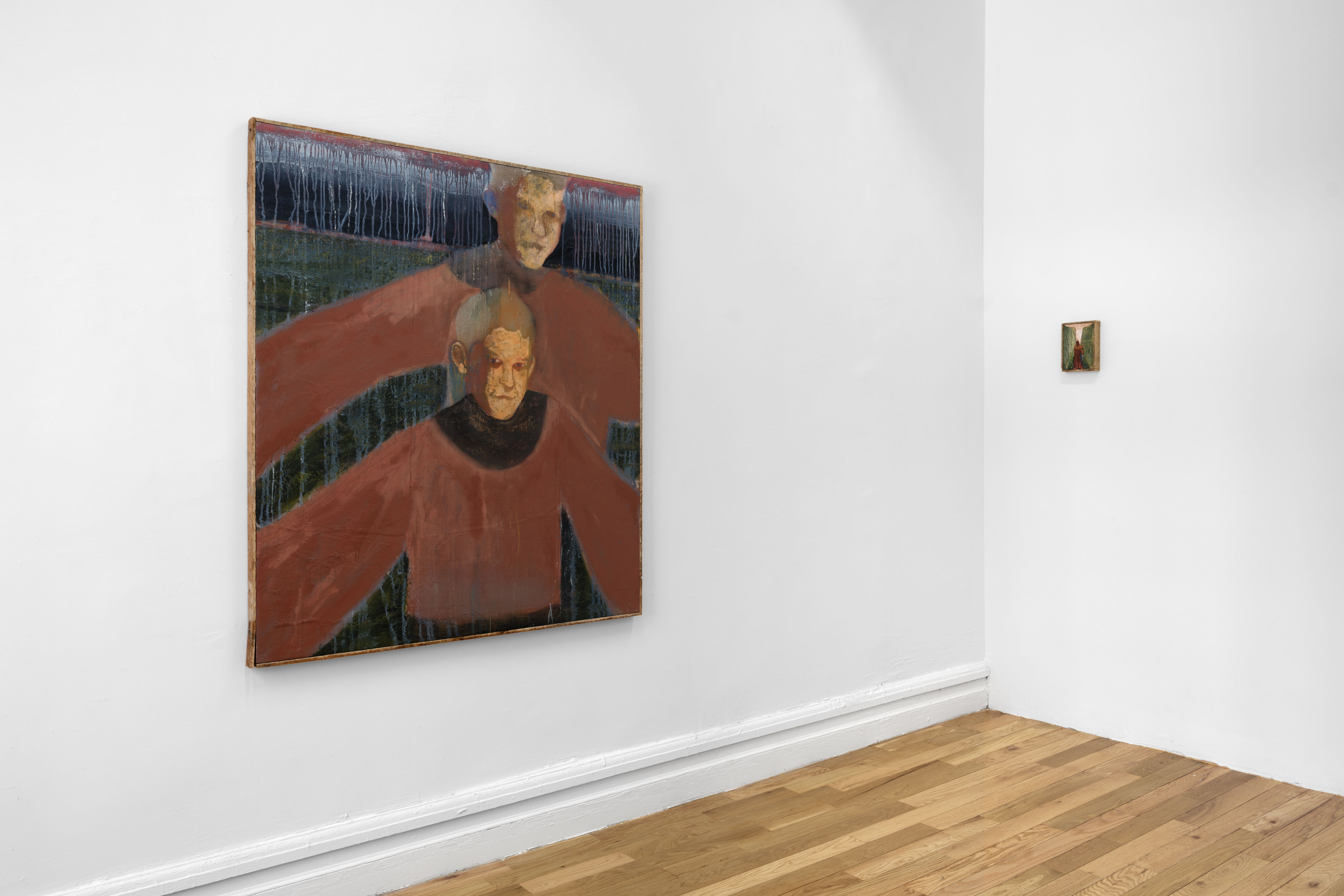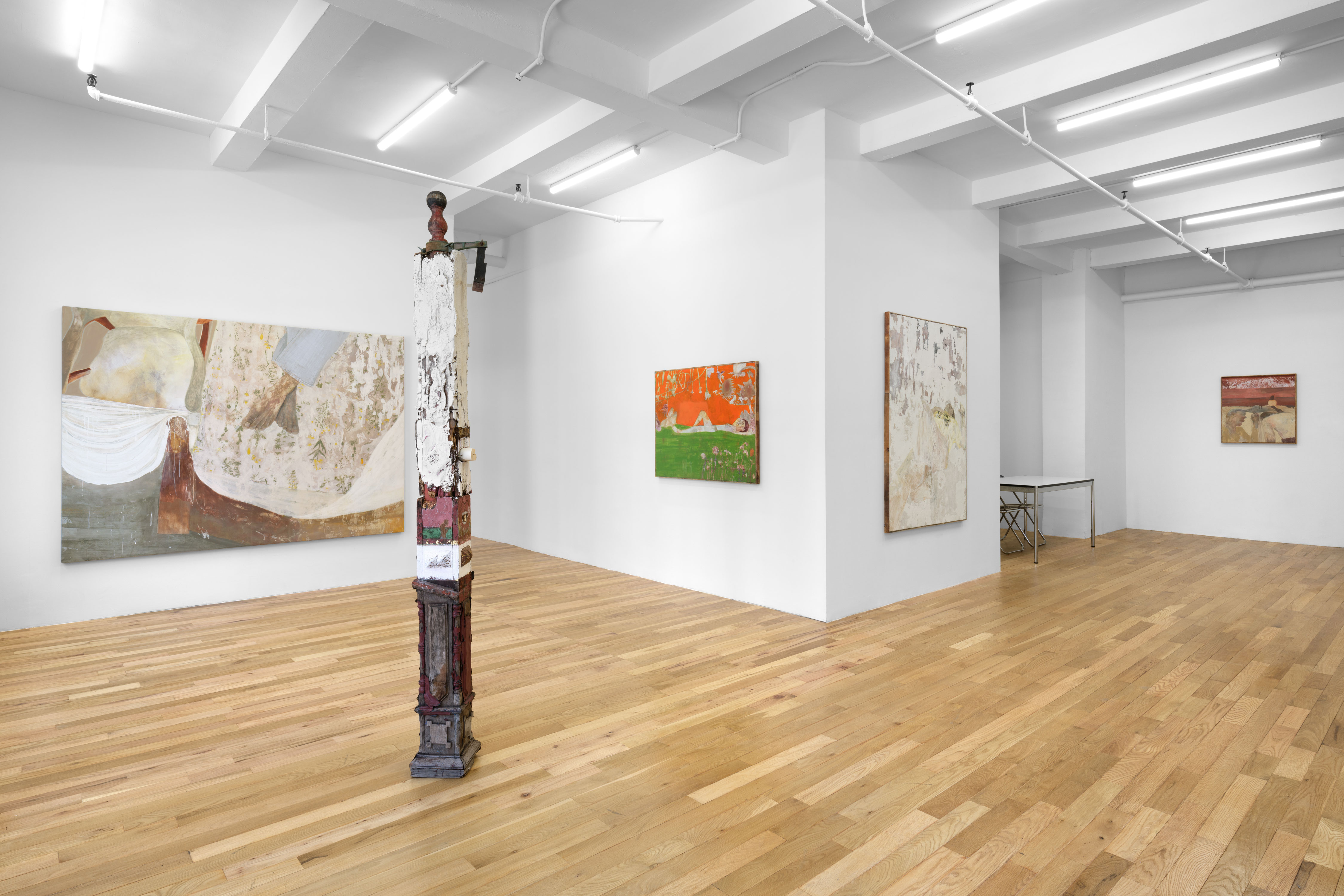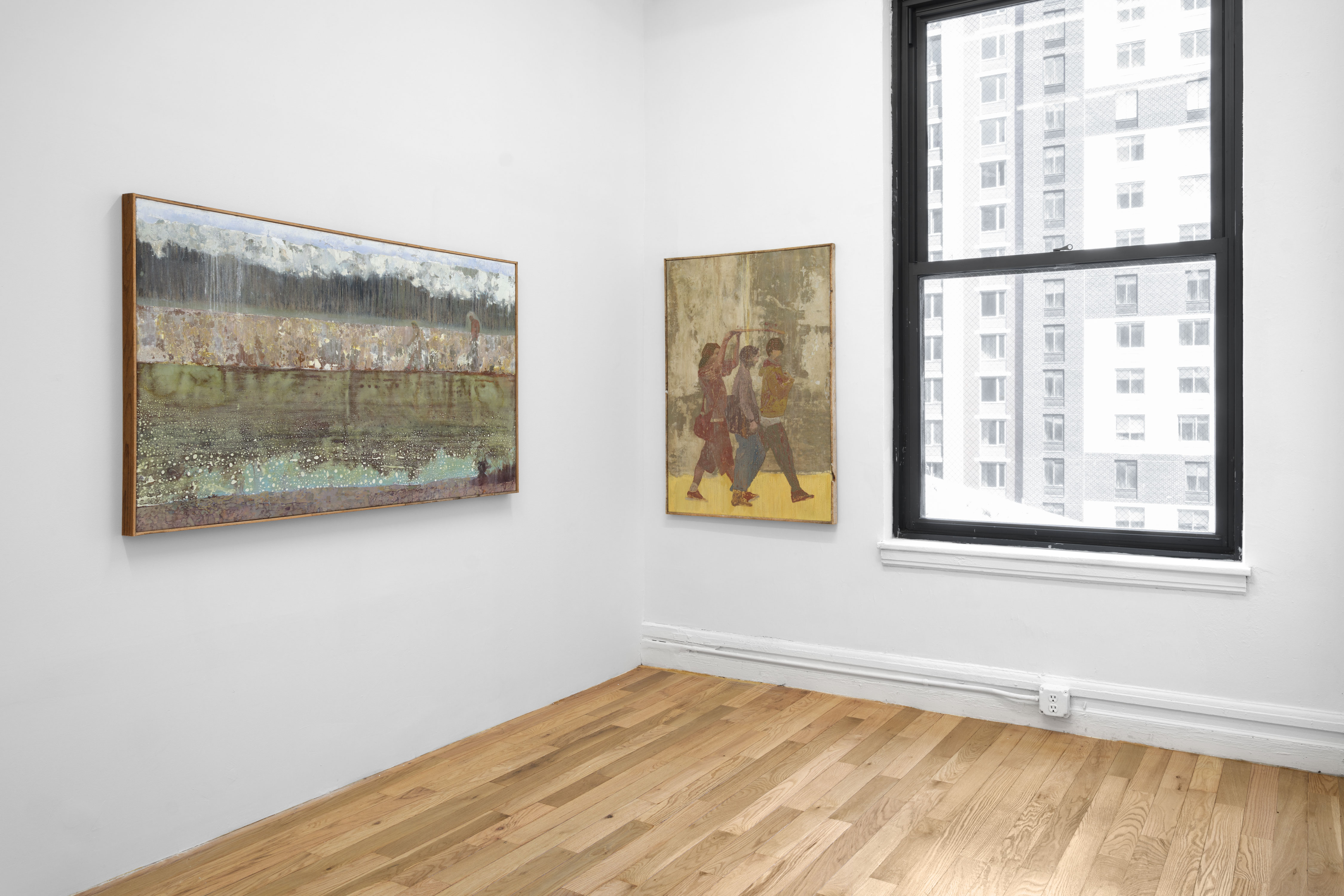Casey Bolding
The river on top of your head
May 7 - June 1, 2024
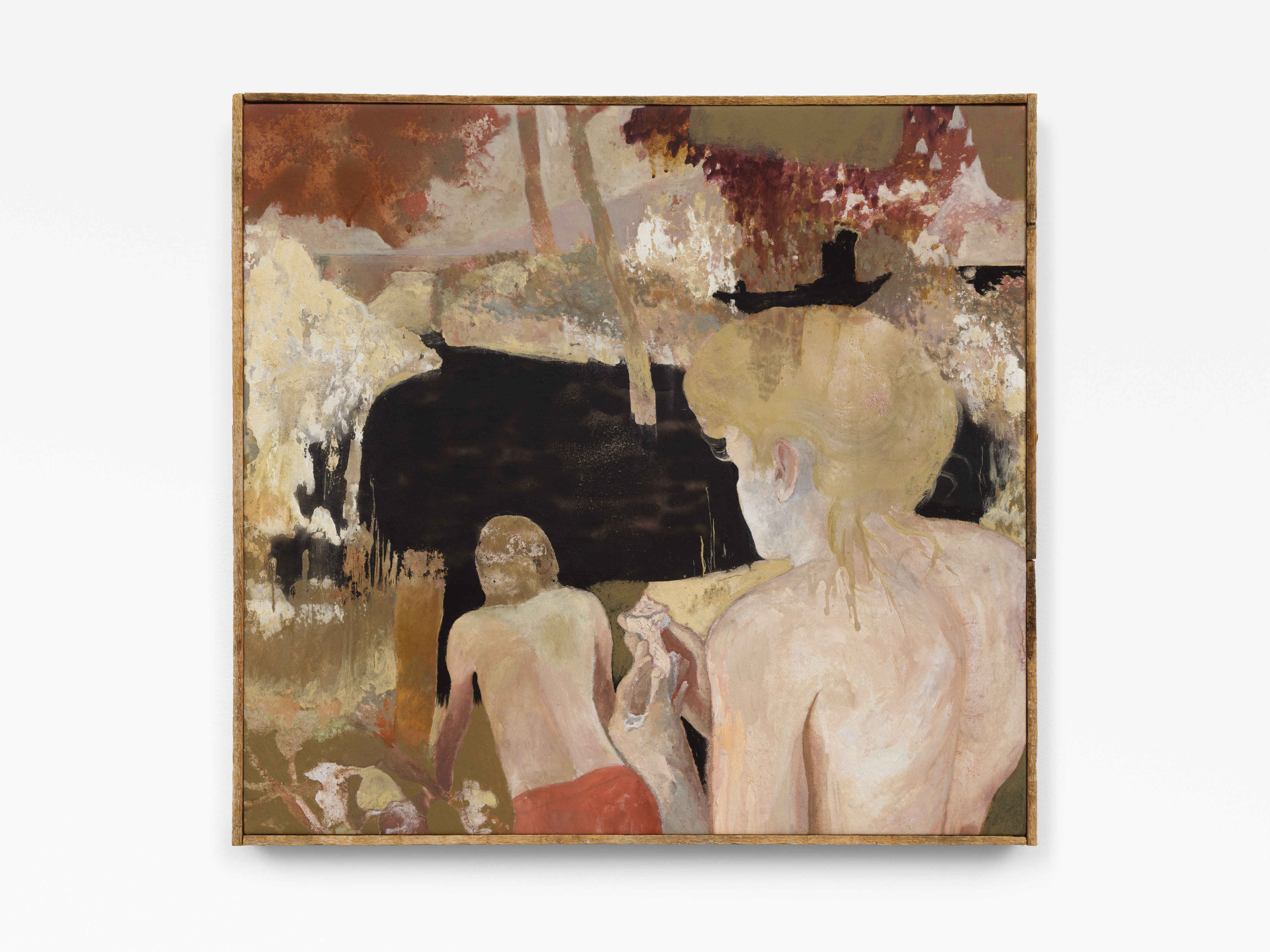
Closer to home, 2024, oil, acrylic, and flashe on canvas
28 3/4 x 30 3/4 inches, 73 x 78.1 cm / Photo: Steven Probert
28 3/4 x 30 3/4 inches, 73 x 78.1 cm / Photo: Steven Probert
Polina Berlin Gallery is pleased to present The river on top of your head, an exhibition of recent work by Casey Bolding, on view from May 7 through June 1, 2024.
Casey calls this show “the river on top of your head,” the river being the way he’s been thinking about time and how it works on you, dictating how you navigate its spurs and crags, how itforms new paths and smooths out the old ones, how it wears down your edges, making you harder and softer at the same time. Everything erodes. Everything rushes downward.
Casey isn’t the first artist to be sensitive to this idea, of course. The Dutch were obsessed with it, plugging skulls into their genteel still-lifes of decomposing fruit, a not-so-veiled reminder that death waits for everyone. Casey has a bit of a lighter touch. His paintings resist bluntness,which is not the same as being aloof. They speak in a poetic register, limpid but not tidy. Faces are obscured, foreground and background are tough to parse, or maybe just open-ended.They’re less interested in narrative than memory, its diffuse shape, the way it tends to shift and molt.
Casey’s introduction to texture came while working with his uncle, applying wall treatments inthe living rooms and kitchens of the Colorado suburbs — faux-distressed old-world simulacra circa early 2000s, when everyone was having their Tuscan villa moment. There was something unheimlich about those walls, even then, manipulating paint to tease out texture, glancing at amemory never experienced, cheating the river of time.
Going from treating walls to treating them as canvas seems a natural leap. People think about graffiti as a violation, but in Casey’s case the opposite is true. To write on a wall, like the dilapidated ones Casey encountered holding up falling-apart New York buildings, or a train, like the ones that would roll under the wide patches of rural Colorado sky, is an appreciation, a tenderness. A graffiti writer is always looking at surfaces, considering their flaws, how to reach an accord with them. But Casey accepts them on their own merits. Of the wall he’s about to paint, Casey thinks, What’s the least I could do to enhance it? To him they’re already beautiful without his intervention, because they already wear the traces of time.
Nearly all of the paintings here employ plaster, and the ones that don’t seem to yearn to, the traditional artist materials — the oil or acrylic or flashe — assuming the matte finish of house paint. In a pair of paintings, each set into horizontal bands stratified like so many layers of earth and mantle and schist, you swear you can make out the lathe substrate — the superficial peeled back to reveal their years: previous coats of paint, built-up bad decisions, worse wallpapers, diversions and wrong turns. Casey paints in lyrical deterioration, a warmth in decay, seized for a Moment.
These are not chromatically intense pictures. Most graffitists favor loud tones — lurid yellowsand obnoxious, toxic greens — their unnatural harshness keyed to jolt you into taking notice. That never jibed well with Casey. His colors feel truer to real life: fungal sepias, rust, muddy, lived-in taupes, “some shitty mauve” — the colors you’re left with in the bucket at the end of theday. The colors of what remains.
Casey’s pictures vibrate between abstraction and figure, never fully resolving into either. They seem more honest for that, an artist who doesn’t purport to have the answers, choosing instead to be open to the possibility that there are none. There’s a clear alliance with the way Mamma Anderson collapses time, Anderson’s spare, northern Sweden swapped for the tones of the landlocked American West and neglected outer borough corners, quiet but with the psychological volume turned up.
Casey’s constructions also can seem to fall apart, which, after all, is how memory works.They’re not new but they’re not ruined either. They appear like a half-remembered dream, shot through with the longing to piece the dream together. The figure in “Thirteen Moons” emerges from a ground of mottled ochres and patched-together clays, snapping into focus briefly beforedissipating again with the same ease. Time folds on itself. Casey likens it to a smell filling your nose: the sweet rot of mildew that works like a portal to the furnace in your grandparents’ house, the loamy bouquet of wet dirt in a clearing. You can sit in the slipstream for a while, with everyone you’ve ever known.
Casey texts me: “It all seems to be going somewhere,” he says, meaning the river. “Maybe just back out into the ocean or for that matter, just back to black. Not an empty black. A full black.”Fullness is a good way to think about it, I agree. The river carries us toward something unseen,but at least the basin will be full.
-Max Lakin
Casey Bolding (b. 1987, Denver) lives and works in Brooklyn, New York. A self taught artist, his work has been included in exhibitions at Polina Berlin Gallery (New York, NY), Shoot the Lobster (New York, NY), Mamoth (London, UK), and 1969 Gallery (New York, NY).
Casey calls this show “the river on top of your head,” the river being the way he’s been thinking about time and how it works on you, dictating how you navigate its spurs and crags, how itforms new paths and smooths out the old ones, how it wears down your edges, making you harder and softer at the same time. Everything erodes. Everything rushes downward.
Casey isn’t the first artist to be sensitive to this idea, of course. The Dutch were obsessed with it, plugging skulls into their genteel still-lifes of decomposing fruit, a not-so-veiled reminder that death waits for everyone. Casey has a bit of a lighter touch. His paintings resist bluntness,which is not the same as being aloof. They speak in a poetic register, limpid but not tidy. Faces are obscured, foreground and background are tough to parse, or maybe just open-ended.They’re less interested in narrative than memory, its diffuse shape, the way it tends to shift and molt.
Casey’s introduction to texture came while working with his uncle, applying wall treatments inthe living rooms and kitchens of the Colorado suburbs — faux-distressed old-world simulacra circa early 2000s, when everyone was having their Tuscan villa moment. There was something unheimlich about those walls, even then, manipulating paint to tease out texture, glancing at amemory never experienced, cheating the river of time.
Going from treating walls to treating them as canvas seems a natural leap. People think about graffiti as a violation, but in Casey’s case the opposite is true. To write on a wall, like the dilapidated ones Casey encountered holding up falling-apart New York buildings, or a train, like the ones that would roll under the wide patches of rural Colorado sky, is an appreciation, a tenderness. A graffiti writer is always looking at surfaces, considering their flaws, how to reach an accord with them. But Casey accepts them on their own merits. Of the wall he’s about to paint, Casey thinks, What’s the least I could do to enhance it? To him they’re already beautiful without his intervention, because they already wear the traces of time.
Nearly all of the paintings here employ plaster, and the ones that don’t seem to yearn to, the traditional artist materials — the oil or acrylic or flashe — assuming the matte finish of house paint. In a pair of paintings, each set into horizontal bands stratified like so many layers of earth and mantle and schist, you swear you can make out the lathe substrate — the superficial peeled back to reveal their years: previous coats of paint, built-up bad decisions, worse wallpapers, diversions and wrong turns. Casey paints in lyrical deterioration, a warmth in decay, seized for a Moment.
These are not chromatically intense pictures. Most graffitists favor loud tones — lurid yellowsand obnoxious, toxic greens — their unnatural harshness keyed to jolt you into taking notice. That never jibed well with Casey. His colors feel truer to real life: fungal sepias, rust, muddy, lived-in taupes, “some shitty mauve” — the colors you’re left with in the bucket at the end of theday. The colors of what remains.
Casey’s pictures vibrate between abstraction and figure, never fully resolving into either. They seem more honest for that, an artist who doesn’t purport to have the answers, choosing instead to be open to the possibility that there are none. There’s a clear alliance with the way Mamma Anderson collapses time, Anderson’s spare, northern Sweden swapped for the tones of the landlocked American West and neglected outer borough corners, quiet but with the psychological volume turned up.
Casey’s constructions also can seem to fall apart, which, after all, is how memory works.They’re not new but they’re not ruined either. They appear like a half-remembered dream, shot through with the longing to piece the dream together. The figure in “Thirteen Moons” emerges from a ground of mottled ochres and patched-together clays, snapping into focus briefly beforedissipating again with the same ease. Time folds on itself. Casey likens it to a smell filling your nose: the sweet rot of mildew that works like a portal to the furnace in your grandparents’ house, the loamy bouquet of wet dirt in a clearing. You can sit in the slipstream for a while, with everyone you’ve ever known.
Casey texts me: “It all seems to be going somewhere,” he says, meaning the river. “Maybe just back out into the ocean or for that matter, just back to black. Not an empty black. A full black.”Fullness is a good way to think about it, I agree. The river carries us toward something unseen,but at least the basin will be full.
-Max Lakin
Casey Bolding (b. 1987, Denver) lives and works in Brooklyn, New York. A self taught artist, his work has been included in exhibitions at Polina Berlin Gallery (New York, NY), Shoot the Lobster (New York, NY), Mamoth (London, UK), and 1969 Gallery (New York, NY).

Kin, 2024, oil and acrylic on canvas
34 x 44 inches, 86.4 x 111.8 cm / Photo: Steven Probert
34 x 44 inches, 86.4 x 111.8 cm / Photo: Steven Probert

Thirteen Moons, 2023, oil, plaster, and flashe on canvas
51 x 41 inches, 129.5 x 104.1 cm / Photo: Steven Probert
51 x 41 inches, 129.5 x 104.1 cm / Photo: Steven Probert

411, 2024, oil and acrylic on canvas
46 x 32 inches, 116.8 x 81.3 cm / Photo: Steven Probert
![]()
![]()
![]()
![]()
![]()
![]()
![]()
![]()
![]()
46 x 32 inches, 116.8 x 81.3 cm / Photo: Steven Probert
